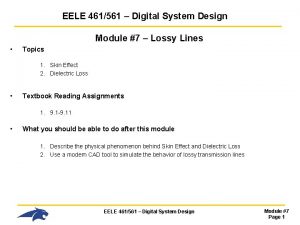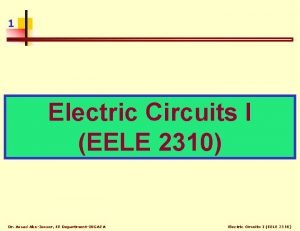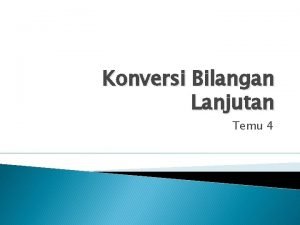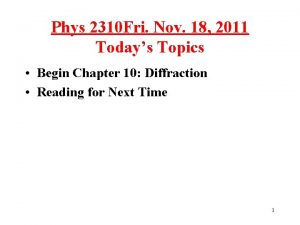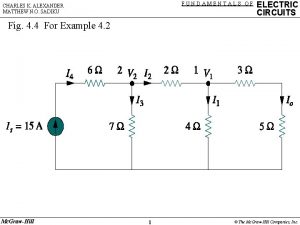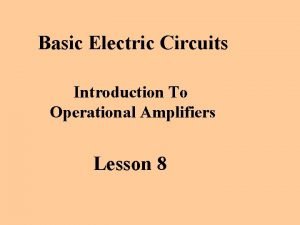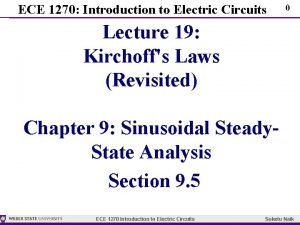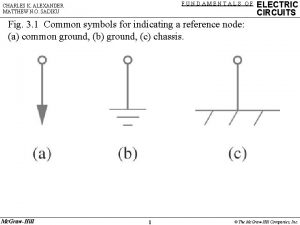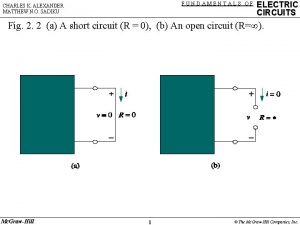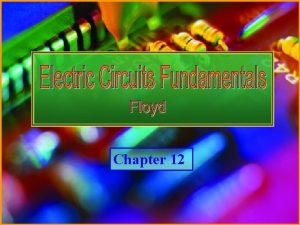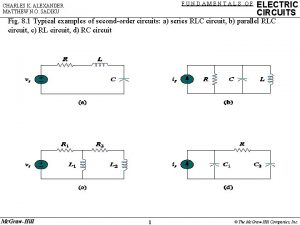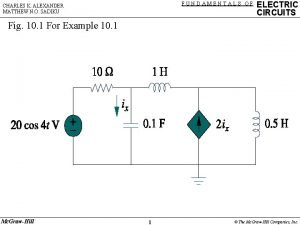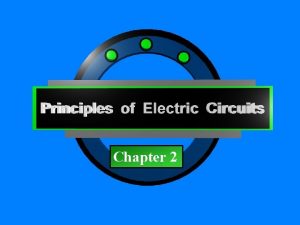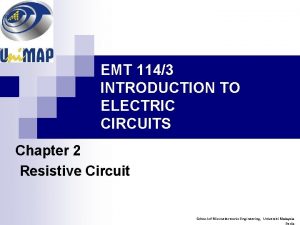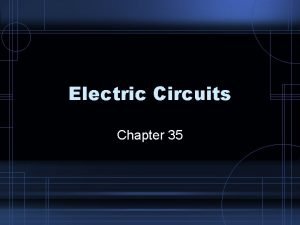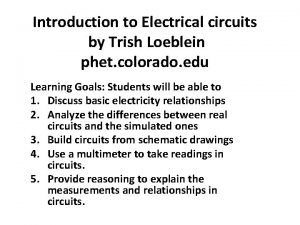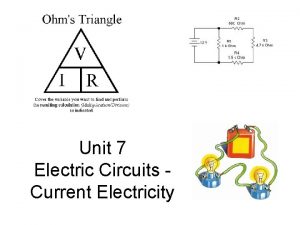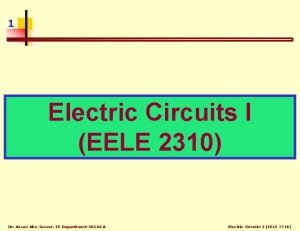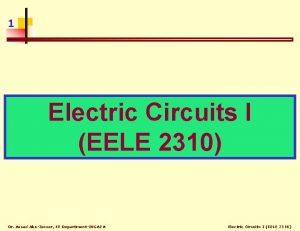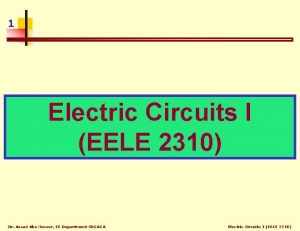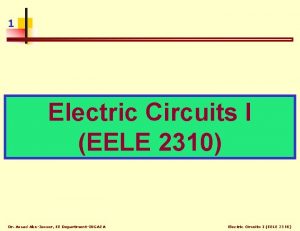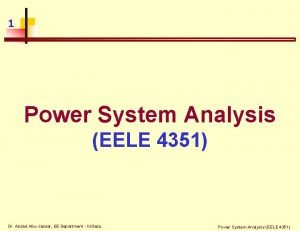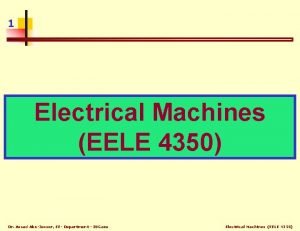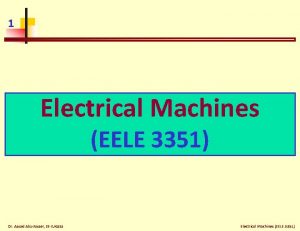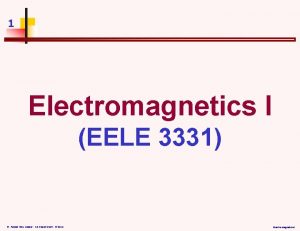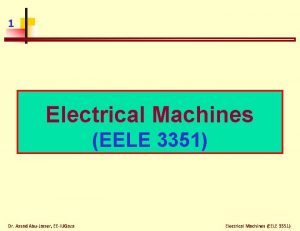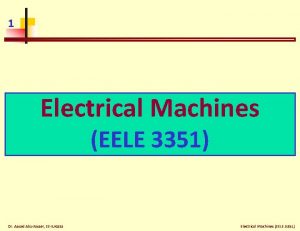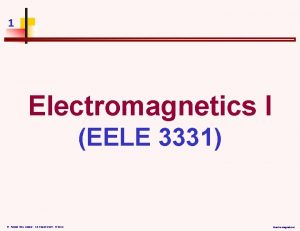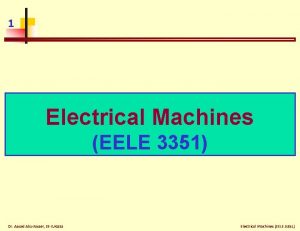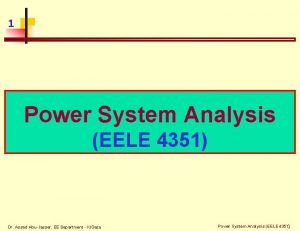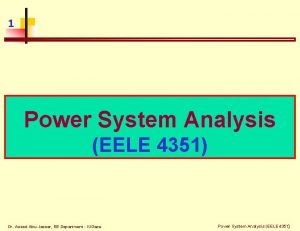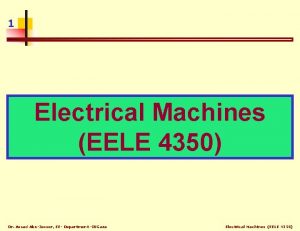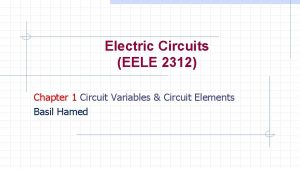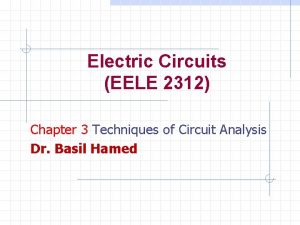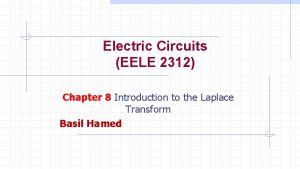1 Electric Circuits I EELE 2310 Dr Assad





























- Slides: 29

1 Electric Circuits I (EELE 2310) Dr. Assad Abu-Jasser, EE Department-IUGAZA Electric Circuits I (EELE 2310)

2 Assad Abu-Jasser, Ph. D Electric Power Engineering site. iugaza. edu. ps/ajasser@iugaza. edu. ps Dr. Assad Abu-Jasser, EE Department-IUGAZA Electric Circuits I (EELE 2310)

3 Chapter Eight Natural and Step Responses of RLC Circuits Dr. Assad Abu-Jasser, EE Department-IUGAZA Electric Circuits I (EELE 2310)

4 Natural and Step Responses of RLC Circuits Dr. Assad Abu-Jasser, EE Department-IUGAZA Electric Circuits I (EELE 2310)

5 Introduction to the Natural Response Parallel RLC Circuit Dr. Assad Abu-Jasser, EE Department-IUGAZA Electric Circuits I (EELE 2310)

6 The Second-Order Differential Equation The General Solution Dr. Assad Abu-Jasser, EE Department-IUGAZA Electric Circuits I (EELE 2310)

7 Example 8 -1 (Parallel RLC Circuit) Finding the Roots of The characteristic Equation a) Find the roots of the characteristic equation that governs the transient behavior of the voltage in the circuit shown if R=200Ω, L=50 m. H, and C=0. 2µF b) Will the response be overdapmed, underdamped, or critically damped? c) Repeat (a) and (b) for R=312. 5 Ω d) What value of R causes the response to be critically damped? Dr. Assad Abu-Jasser, EE Department-IUGAZA Electric Circuits I (EELE 2310)

8 The Natural Response of Parallel RLC Circuit The Overdamped Voltage Response Find the roots of the characteristic equation (s 1, s 2) using R, L, and C Find ʋ(0+) and dʋ(0+)/dt Find the values of A 1 and A 2 Substitute the values of these variable to determine the expression Dr. Assad Abu-Jasser, EE Department-IUGAZA Electric Circuits I (EELE 2310)

9 Example 8 -2 Parallel RLC Circuit Overdamped Natural Response For the circuit shown ʋ(0+)=12 V, and i. L(0+)=30 m. A. a) Find the initial current in each branch of the circuit b) Find the initial value of dʋ(0+)/dt c) Find the expression for ʋ(t) d) Sketch ʋ(t) in the interval 0 ≤ t ≤ 250 ms Dr. Assad Abu-Jasser, EE Department-IUGAZA Electric Circuits I (EELE 2310)

10 Example 8 -3 Calculating Branch Current Natural Response Derive the expression that describe three branch current i. R, i. L, and i. C during the time the stored energy is being released for Example (8 -2). Dr. Assad Abu-Jasser, EE Department-IUGAZA Electric Circuits I (EELE 2310)

11 The Natural Response of Parallel RLC Circuit The Underdamped Voltage Response Dr. Assad Abu-Jasser, EE Department-IUGAZA Electric Circuits I (EELE 2310)

12 Example 8 -4 Parallel RLC Circuit Underdamped Natural Response In the circuit shown V 0=0, and I 0=-12. 25 m. A a) Calculate the roots of the characteristic equation b) Calculate ʋ and dʋ(0+)/dt c) Calculate the voltage response for t ≥ 0 d) Plot ʋ(t) versus t for the time interval 0 ≤ t ≤ 11 ms Dr. Assad Abu-Jasser, EE Department-IUGAZA Electric Circuits I (EELE 2310)

13 The Underdamped Response The Characteristics Dr. Assad Abu-Jasser, EE Department-IUGAZA Electric Circuits I (EELE 2310)

14 The Natural Response of Parallel RLC Circuit The Critically Damped Voltage Response Dr. Assad Abu-Jasser, EE Department-IUGAZA Electric Circuits I (EELE 2310)

15 Example 8 -5 Parallel RLC Circuit Critically Damped Natural Response For the circuit shown V 0=0, and I 0=-12. 25 m. A a) Find the value of R that results in a critically damped voltage response b) Calculate ʋ(t) for t ≥ 0 c) Plot ʋ(t) versus t for the time interval 0 ≤ t ≤ 7 ms Dr. Assad Abu-Jasser, EE Department-IUGAZA Electric Circuits I (EELE 2310)

16 The Step Response of a Parallel RLC Circuit Dr. Assad Abu-Jasser, EE Department-IUGAZA Electric Circuits I (EELE 2310)

17 The Step Response of a Parallel RLC Circuit The Indirect Approach Solution Dr. Assad Abu-Jasser, EE Department-IUGAZA Electric Circuits I (EELE 2310)

18 The Step Response of a Parallel RLC Circuit The Direct Approach Solution Dr. Assad Abu-Jasser, EE Department-IUGAZA Electric Circuits I (EELE 2310)

19 Example 8 -6 Overdamped Step Response of a Parallel RLC Circuit The initial energy stored in the circuit shown is zero. At t=0, a dc current source of 24 m. A is applied to the circuit. The value of the resistance is 400 Ω. a) What is the initial value of i. L? b) What is the initial value of di. L/dt? c) What are the roots of the characteristic equation? d) What is the numerical expression No energy is initially stored in the for i. L(t) when t ≥ 0? circuit The inductor initial current is zero, so i. L(0+) equals zero The capacitor initial voltage is zero, so ʋC(0+) equals zero The value of ʋ=Ldi. L/dt=0, therefore di. L(0+)/dt=0 Dr. Assad Abu-Jasser, EE Department-IUGAZA Electric Circuits I (EELE 2310)

20 Example 8 -7 Underdamped Step Response of a Parallel RLC Circuit The initial energy stored in the circuit shown is zero. At t=0, a dc current source of 24 m. A is applied to the circuit. The value of the resistance is 625 Ω. a) What is the initial value of i. L? b) What is the initial value of di. L/dt? c) What are the roots of the characteristic equation? d) What is the numerical expression No energy is initially stored in the for i. L(t) when t ≥ 0? circuit The inductor initial current is zero, so i. L(0+) equals zero The capacitor initial voltage is zero, so ʋC(0+) equals zero The value of ʋ=Ldi. L/dt=0, therefore di. L(0+)/dt=0 Dr. Assad Abu-Jasser, EE Department-IUGAZA Electric Circuits I (EELE 2310)

21 Example 8 -8 Critically Damped Step Response of a Parallel RLC Circuit The initial energy stored in the circuit shown is zero. At t=0, a dc current source of 24 m. A is applied to the circuit. The value of the resistance is 500 Ω. a) What is the initial value of i. L? b) What is the initial value of di. L/dt? c) What are the roots of the characteristic equation? d) What is the numerical expression No energy is initially stored in the for i. L(t) when t ≥ 0? circuit The inductor initial current is zero, so i. L(0+) equals zero The capacitor initial voltage is zero, so ʋC(0+) equals zero The value of ʋ=Ldi. L/dt=0, therefore di. L(0+)/dt=0 Dr. Assad Abu-Jasser, EE Department-IUGAZA Electric Circuits I (EELE 2310)

22 Example 8 -9 Comparing the Three-Step Response Forms a) Plot on a single graph, over a range from 0 theofoverdamped, The 220 finalµs, value i. L is 24 m. A underdamped, and critically damped responses derived examples 8. 6 -8. 8. 90% ofin. If=I L(∞)=21. 6 m. A b) Use the plots of (a) to find the time required fortodi. L=130 to reach 90% of its final µs value. tcd=97 µs c) On the basis of the results obtained in (b), which response tud=74 µs would you specify in a design that puts a premium on reaching 90% of. The theunderdamped final value of response the output in the shortest time? reachs the 90% of the final d) Which response would you specify in a design that must ensure that the final value in the fastest time, so it value of the current is never exceeded? is the desired design. Critically and overdamped responses meet the design. Practically overdamped is better Dr. Assad Abu-Jasser, EE Department-IUGAZA Electric Circuits I (EELE 2310)

23 Example 8 -10 Parallel RLC Step Response with Initial Stored Energy is stored in the circuit shown at the instant the dc current is applied. The initial current in the inductor is 29 m. A, and the initial voltage across the capacitor is 50 V. The value of the resistance is 500 Ω. find: a) The initial value of the current i. L(0+) b) The initial value of di. L(0+)/dt c) An expression i. L(t) for t≥ 0 Energy is initiallyfor stored in the circuit d) An expression for ʋ(t) for t ≥ 0 due to i. L(0) and ʋC(0) Initially the inductor current is 29 m. A, therefore i. L(0+) equals 29 m. A Initial the capacitor voltage is 50 V, therefore ʋC(0+) equals 50 V The value ʋ=Ldi. L(0+)/dt=50, therefore di. L(0+)/dt=50/0. 025=2000 A/s Dr. Assad Abu-Jasser, EE Department-IUGAZA Electric Circuits I (EELE 2310)

24 The Natural Response of a Series RLC Circuit Dr. Assad Abu-Jasser, EE Department-IUGAZA Electric Circuits I (EELE 2310)

25 The Step Response of a Series RLC Circuit Dr. Assad Abu-Jasser, EE Department-IUGAZA Electric Circuits I (EELE 2310)

26 Example 8 -11 Underdamped Natural Response of a Series RLC Circuit The 0. 1 µF capacitor in the circuit shown is charged to 100 V. At t=0 the capacitor is discharged through a series combination of 100 m. H inductor and a 560 Ω resistor. a) Find i(t) for t ≥ 0 b) Find ʋC(t) for t ≥ 0 Dr. Assad Abu-Jasser, EE Department-IUGAZA Electric Circuits I (EELE 2310)

27 Example 8 -12 Underdamped Step Response of a Series RLC Circuit No energy is stored in the 100 m. H inductor or the 0. 4 µF capacitor when the switch in the circuit shown is closed. Find ʋC(t) for t ≥ 0 ms Dr. Assad Abu-Jasser, EE Department-IUGAZA Electric Circuits I (EELE 2310)

28 Natural and Step Responses of RLC Circuits Summary Dr. Assad Abu-Jasser, EE Department-IUGAZA Electric Circuits I (EELE 2310)

29 End of Chapter Eight Dr. Assad Abu-Jasser, EE Department-IUGAZA Electric Circuits I (EELE 2310)
 Characteristic impedance definition
Characteristic impedance definition Jonathan eele
Jonathan eele Dr nabil assad
Dr nabil assad Dr nabil assad
Dr nabil assad Heksadesimal
Heksadesimal 2310
2310 Konersi
Konersi Advantages of parallel circuit over series circuit
Advantages of parallel circuit over series circuit Fundamentals of electric circuits
Fundamentals of electric circuits Electric circuits equations
Electric circuits equations Introduction to electric circuits
Introduction to electric circuits Fundamentals of electric
Fundamentals of electric Circuits ohm's law worksheet answers
Circuits ohm's law worksheet answers Electric current
Electric current Sadiku
Sadiku Electric circuits fundamentals floyd
Electric circuits fundamentals floyd Fundamentals of electric circuits
Fundamentals of electric circuits Fundamentals of electric circuits chapter 7 solutions
Fundamentals of electric circuits chapter 7 solutions The circuit chapter 9
The circuit chapter 9 Quarturs
Quarturs Alexander
Alexander Principles of electric circuits
Principles of electric circuits Conceptual physics chapter 35 electric circuits
Conceptual physics chapter 35 electric circuits Introduction to electric circuits
Introduction to electric circuits Superposition electric circuits
Superposition electric circuits Chapter 35 electric circuits answers
Chapter 35 electric circuits answers Basic electrical engineering kulshreshtha
Basic electrical engineering kulshreshtha Chapter 35 electric circuits
Chapter 35 electric circuits Phet circuit
Phet circuit Circuit symbols
Circuit symbols
